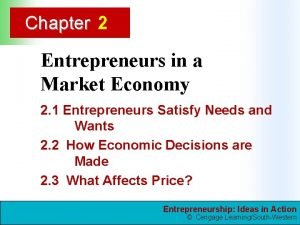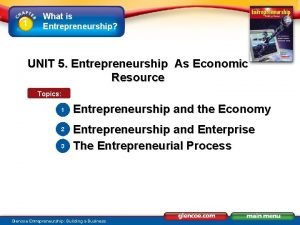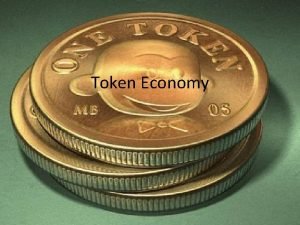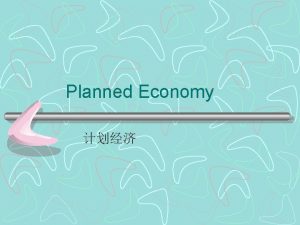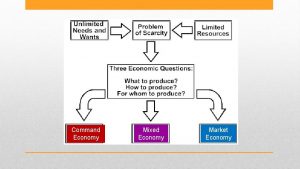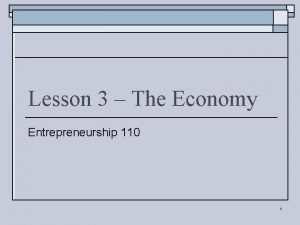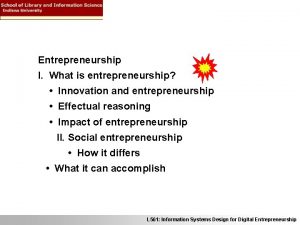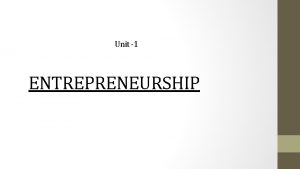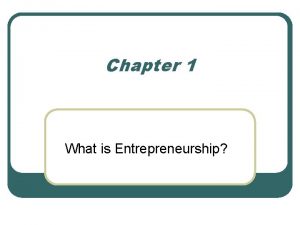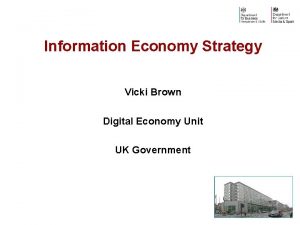Entrepreneurship Unit 1 Entrepreneurship and the Economy Entrepreneurship





















- Slides: 21

Entrepreneurship Unit 1 - Entrepreneurship and the Economy

Entrepreneurship The process of getting into and operating one’s own business.

Entrepreneur An individual who undertakes the creation, organization and ownership of a business. He or she accepts the risks and responsibilities of business ownership to gain profits and personal satisfaction.

Economics The study of how people choose to allocate scarce resources to fulfill their unlimited wants. Economics has a profound influence on entrepreneurship.

Economic Systems Must answer 4 questions. 1. What goods and services should be produced? 2. What quantity of goods and services should be produced? 3. How should goods and services be produced? 4. For whom should goods and services be produced?

Economic Systems History has produced several different types of economic systems: Traditional-relies on farming and simple barter trade Mid-evil times Command- run by a strong centralized government Communism Market-based on supply and demand with little government control. The Free Enterprise System Mixed-Now based on the combined principles of market and command economies.

The Free Enterprise System An economic system in which people have the right to make economic choices. People can choose what products to buy. People can choose to own private property. People can choose to start a business and compete with other businesses. Without the Free Enterprise System Entrepreneurship would not be possible. It is a vital component

The Role of Competition between similar businesses is one of the basic characteristics of a Free Enterprise System. Businesses compete on the basis of price and nonprice factors Why? Provides choices Forces companies to improve quality and become more efficient

Profit Motive Profit: Money left after all the expenses of a business have been deducted from the income. Making a profit is a primary incentive of the free enterprise system. It is one way of measuring success in a free enterprise system.

The Role of Comparison Price Non-Price Quality Leads to a surplus which brings price down. Service Lower costs come from Reputation producing in higher volume and a more experienced workforce

Market Structure Refers to the nature and degree of competition among businesses operating in the same industry. Market structure affects market price. 4 different types of market structures. 1. Perfect Competition 2. Monopolistic Competition 3. Monopoly 4. Oligopoly

Market Structures Perfect Competition Market with numerous buyers and sellers and no single buyer or seller can affect price. Monopolistic Competition Many sellers produce similar but differentiated products. Sellers have some power to control the price of their products.

Market Structures Monopoly When a company controls all of a market. There is no competition A company that has a monopoly is able to charge more than a company that has to compete with other companies. Consumers have nowhere else to go. They will continue to buy a product or service even if the producer raises prices. Oligopoly When there are just a few competing firms. Such as the automobile industry.

Factors of Production The resources businesses use to produce the goods and services that people want. 1. Land- Natural resources 2. Labor-human effort used to produce goods and services 3. Capital- the equipment, factory, tools and other goods needed to produce a product. 4. Entrepreneurship-The ideas and decisions of the business owner. They bring together the other factors to create value.

Goods and Services are the products our economic system produces to satisfy consumers’ wants and needs. Goods are tangible products Services are intangible products Need-a basic requirement for survival Want- something you don’t have to have for survival but would like to have.

Supply The amount of a good or service that producers are willing and able to produce The more money that can be charged for each item… the more units the supplier is willing to produce.

Demand The amount or quantity of goods or services that consumers are willing and able to buy. As the price continues to rise. . . the less units the consumer is willing to buy.

Elastic vs Inelastic Demand Elastic Demand A change in price creates a change in demand. Example Butter- there are lower priced substitutes and can be replaced Inelastic Demand A change in price has very little effect on demand for products. Examples: Milk- no substitutes Gasoline- no substitute

Inelastic demand Demand tends to be inelastic in these circumstances: No acceptable substitutes are available, and customers need the product. The price change is small and relative to buyer income, so if customers want the product, they will buy it. The product is a necessity; customers need it. Even when a product’s price is low people won’t keep buying it indefinitely due to diminishing marginal utility.

Diminishing Marginal Utility Price alone doesn’t determine demand. Other factors due such as: Income Taste How much they already own

Supply & Demand If something is in heavy demand but short in supply, prices will go up. The rise in price will reduce demand expand supply. If something is in heavy supply but in short demand, prices will go down. The fall in price will expand demand contract supply Prices tend to stabilize at the level where demand equals supply. Equilibrium
 Athenian economy vs sparta economy
Athenian economy vs sparta economy Entrepreneurs in a market economy
Entrepreneurs in a market economy Introduction to entrepreneurship module pdf
Introduction to entrepreneurship module pdf Unit 6 review questions
Unit 6 review questions Unit 5 entrepreneurship and business
Unit 5 entrepreneurship and business Hát kết hợp bộ gõ cơ thể
Hát kết hợp bộ gõ cơ thể Lp html
Lp html Bổ thể
Bổ thể Tỉ lệ cơ thể trẻ em
Tỉ lệ cơ thể trẻ em Gấu đi như thế nào
Gấu đi như thế nào Glasgow thang điểm
Glasgow thang điểm Chúa yêu trần thế
Chúa yêu trần thế Các môn thể thao bắt đầu bằng tiếng nhảy
Các môn thể thao bắt đầu bằng tiếng nhảy Thế nào là hệ số cao nhất
Thế nào là hệ số cao nhất Các châu lục và đại dương trên thế giới
Các châu lục và đại dương trên thế giới Công thức tính thế năng
Công thức tính thế năng Trời xanh đây là của chúng ta thể thơ
Trời xanh đây là của chúng ta thể thơ Mật thư anh em như thể tay chân
Mật thư anh em như thể tay chân 101012 bằng
101012 bằng Phản ứng thế ankan
Phản ứng thế ankan Các châu lục và đại dương trên thế giới
Các châu lục và đại dương trên thế giới Thể thơ truyền thống
Thể thơ truyền thống

